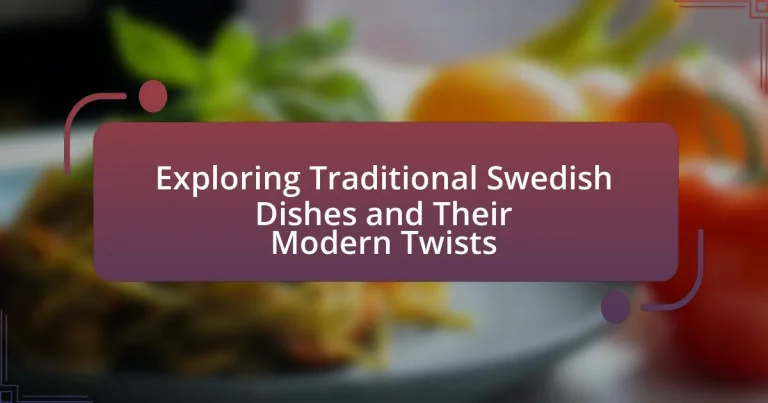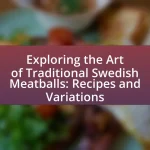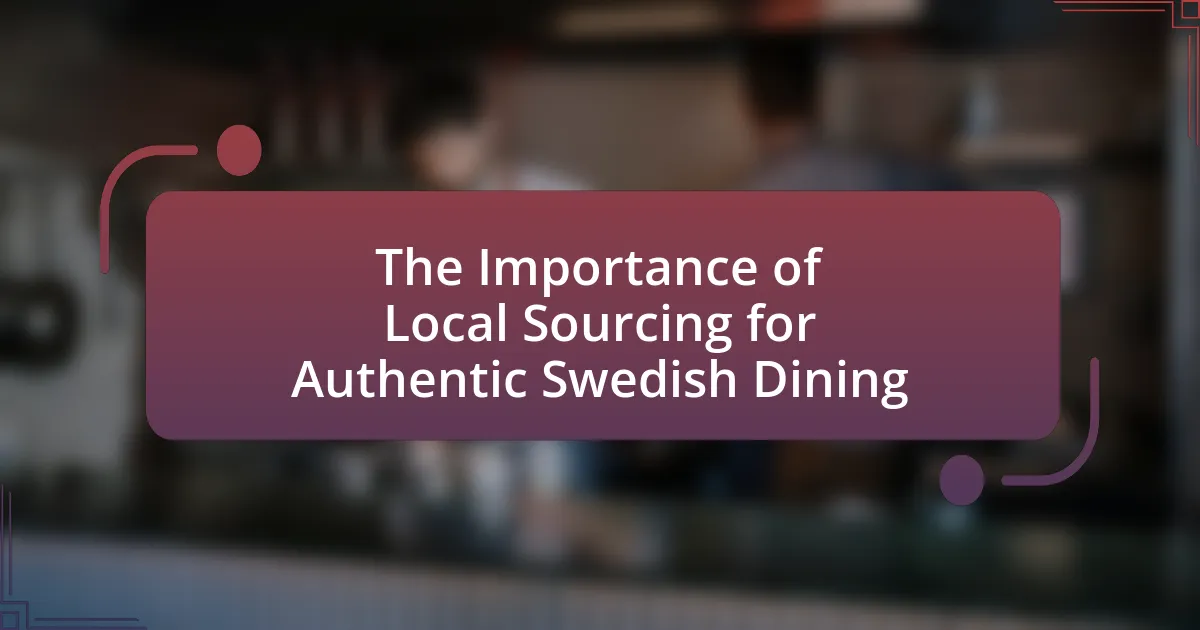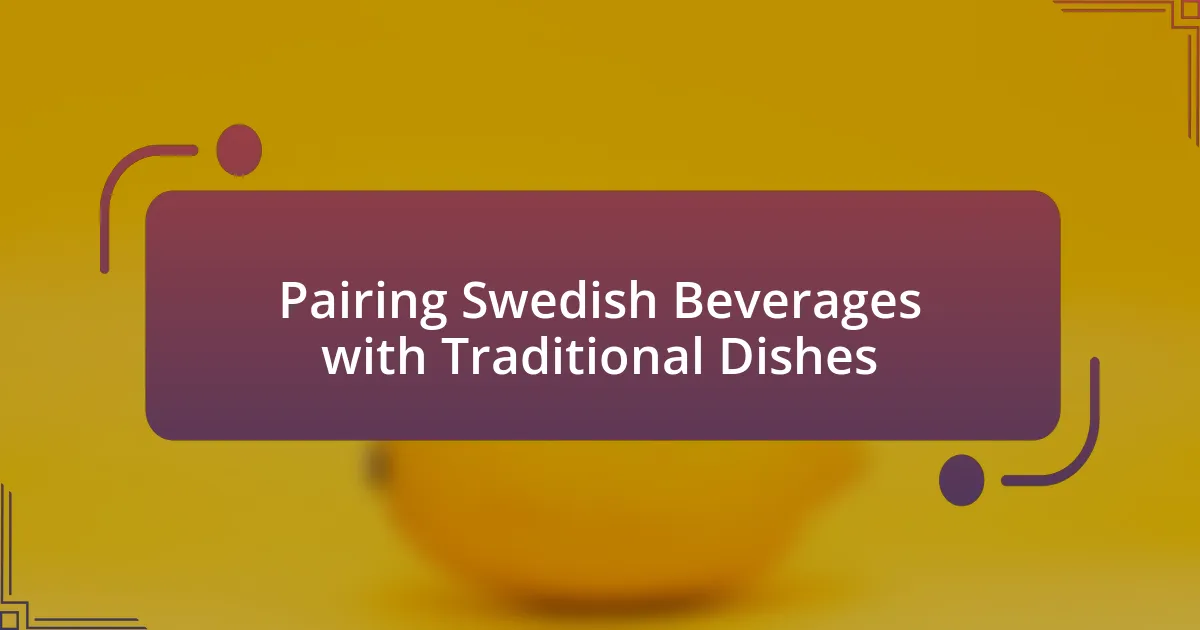The article focuses on Traditional Swedish Dishes and their evolution over time, highlighting iconic foods such as meatballs, herring, and gravlax. It examines the historical influences that shaped Swedish cuisine, including preservation methods and regional variations that impact ingredient choices and flavors. Additionally, the article explores modern adaptations of traditional recipes, reflecting contemporary dietary trends and innovative cooking techniques. Key ingredients and essential tools for Swedish cooking are also discussed, along with tips for recreating these dishes at home. Overall, the piece provides a comprehensive overview of Sweden’s culinary heritage and its modern interpretations.
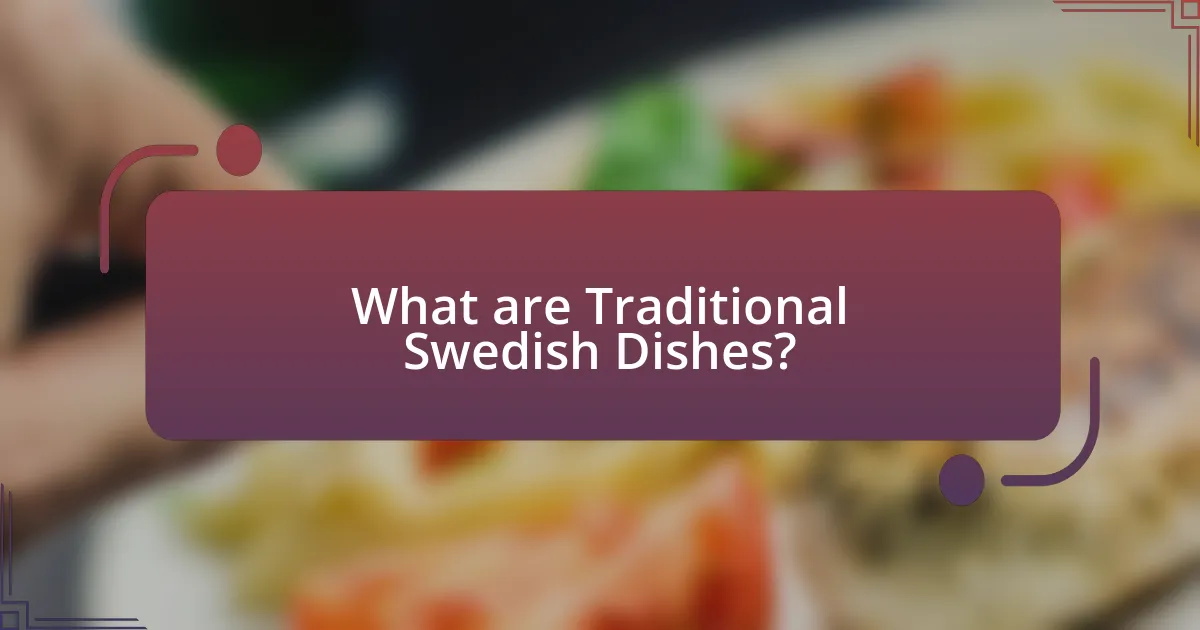
What are Traditional Swedish Dishes?
Traditional Swedish dishes include meatballs, herring, and gravlax. Swedish meatballs, known as köttbullar, are typically made from a mixture of ground beef and pork, served with lingonberry sauce and creamy gravy. Herring, often pickled, is a staple in Swedish cuisine, commonly served during festive occasions. Gravlax, a cured salmon dish, is seasoned with sugar, salt, and dill, showcasing the country’s seafood traditions. These dishes reflect Sweden’s agricultural and maritime heritage, emphasizing local ingredients and traditional cooking methods.
How have Traditional Swedish Dishes evolved over time?
Traditional Swedish dishes have evolved significantly over time, influenced by historical events, globalization, and changing dietary preferences. Initially, traditional Swedish cuisine was characterized by preservation methods such as pickling, smoking, and drying, which were essential for surviving harsh winters. For example, dishes like herring and cured meats were staples due to their long shelf life.
In the 20th century, the introduction of refrigeration and transportation expanded access to fresh ingredients, leading to a shift towards more diverse and contemporary cooking styles. This evolution is evident in the incorporation of international flavors and ingredients, as seen in modern interpretations of classic dishes like meatballs, which now often include spices and sauces from various cuisines.
Additionally, the rise of health consciousness has prompted adaptations in traditional recipes, with a focus on organic and locally sourced ingredients. For instance, traditional dishes are increasingly being reimagined to include whole grains and vegetables, reflecting a modern emphasis on nutrition.
Overall, the evolution of traditional Swedish dishes illustrates a dynamic interplay between heritage and innovation, adapting to societal changes while retaining core elements of Swedish culinary identity.
What historical influences shaped Traditional Swedish Cuisine?
Traditional Swedish cuisine has been shaped by various historical influences, including geography, climate, and cultural exchanges. The harsh Nordic climate necessitated preservation methods such as smoking, pickling, and fermenting, which are foundational to Swedish food practices. Additionally, trade routes established during the Viking Age introduced spices and ingredients from other cultures, enriching local dishes. The agricultural practices of the Middle Ages, particularly the cultivation of rye and barley, further defined staple foods in Sweden. Furthermore, the influence of neighboring countries, especially during periods of political union, brought new culinary techniques and flavors, contributing to the evolution of traditional Swedish cuisine.
How do regional variations impact Traditional Swedish Dishes?
Regional variations significantly impact Traditional Swedish Dishes by influencing the ingredients, preparation methods, and flavors unique to each area. For instance, coastal regions often incorporate seafood, such as herring and salmon, while inland areas may focus on game meats and root vegetables, reflecting local availability. Additionally, the use of spices and herbs can vary, with southern regions favoring more robust flavors compared to the milder tastes found in the north. This diversity is evident in dishes like Jansson’s Temptation, which may feature different types of potatoes or cream based on regional preferences. Historical trade routes and agricultural practices have further shaped these variations, ensuring that traditional recipes evolve while still honoring their origins.
What are the key ingredients in Traditional Swedish Dishes?
Key ingredients in traditional Swedish dishes include potatoes, herring, lingonberries, meat (especially beef and pork), and dairy products like cream and cheese. Potatoes serve as a staple side, often prepared in various forms such as boiled or mashed. Herring, commonly pickled, is a significant component in dishes like sill. Lingonberries provide a tart contrast to savory meals, frequently accompanying meat dishes. Beef and pork are central to many traditional recipes, including meatballs and cured meats. Dairy products, particularly cream, are essential in sauces and desserts, reflecting Sweden’s agricultural heritage.
Which local ingredients are essential in Swedish cooking?
Essential local ingredients in Swedish cooking include potatoes, herring, lingonberries, and dill. Potatoes serve as a staple side dish, often featured in various forms such as boiled or mashed. Herring is a key fish used in traditional dishes like pickled herring, reflecting Sweden’s coastal geography. Lingonberries are commonly used in sauces and jams, providing a tart flavor that complements many meals. Dill is a prevalent herb in Swedish cuisine, often used to season fish and potatoes. These ingredients are integral to the culinary identity of Sweden, showcasing the country’s agricultural and maritime resources.
How do seasonal ingredients affect Traditional Swedish Dishes?
Seasonal ingredients significantly influence traditional Swedish dishes by dictating the availability and freshness of key components. For instance, dishes like gravlax utilize fresh salmon during the summer months when it is abundant, enhancing flavor and quality. Additionally, root vegetables such as potatoes and carrots are harvested in the fall, leading to their prominent use in hearty winter meals like Janssons frestelse. This reliance on seasonal produce not only reflects the agricultural cycles of Sweden but also promotes sustainability and local sourcing, as highlighted by the Swedish Food Agency, which encourages the consumption of seasonal foods to reduce environmental impact.
What are some iconic Traditional Swedish Dishes?
Iconic traditional Swedish dishes include meatballs, herring, and gravlax. Swedish meatballs, known as “köttbullar,” are typically served with lingonberry sauce and creamy gravy, reflecting Sweden’s culinary heritage. Herring, often pickled, is a staple in Swedish cuisine, commonly enjoyed during festive occasions and as part of the smorgasbord. Gravlax, a cured salmon dish, is seasoned with sugar, salt, and dill, showcasing the importance of fish in Swedish gastronomy. These dishes are not only popular in Sweden but also represent the country’s rich food culture and history.
What is the significance of Meatballs in Swedish cuisine?
Meatballs hold significant cultural and culinary importance in Swedish cuisine, symbolizing traditional home-cooked meals and national identity. Known as “köttbullar,” these meatballs are typically made from a mixture of ground beef and pork, seasoned with spices, and served with lingonberry sauce and creamy gravy. Their historical roots trace back to the 18th century, reflecting Sweden’s agricultural practices and the influence of various European cuisines. The dish has become a staple in Swedish households and is often featured in festive occasions, showcasing its role in both everyday life and celebrations.
How is Surströmming prepared and served?
Surströmming is prepared by fermenting herring in a brine solution for several months, typically in barrels, which allows the fish to develop its distinct strong odor and flavor. After fermentation, the fish is canned, where it continues to ferment until opened. Surströmming is traditionally served with thin flatbreads, boiled potatoes, and diced onions, often accompanied by sour cream or a strong Swedish beer to balance its intense taste. This preparation method and serving style reflect the traditional Swedish culinary practice of utilizing preserved fish, which dates back centuries.
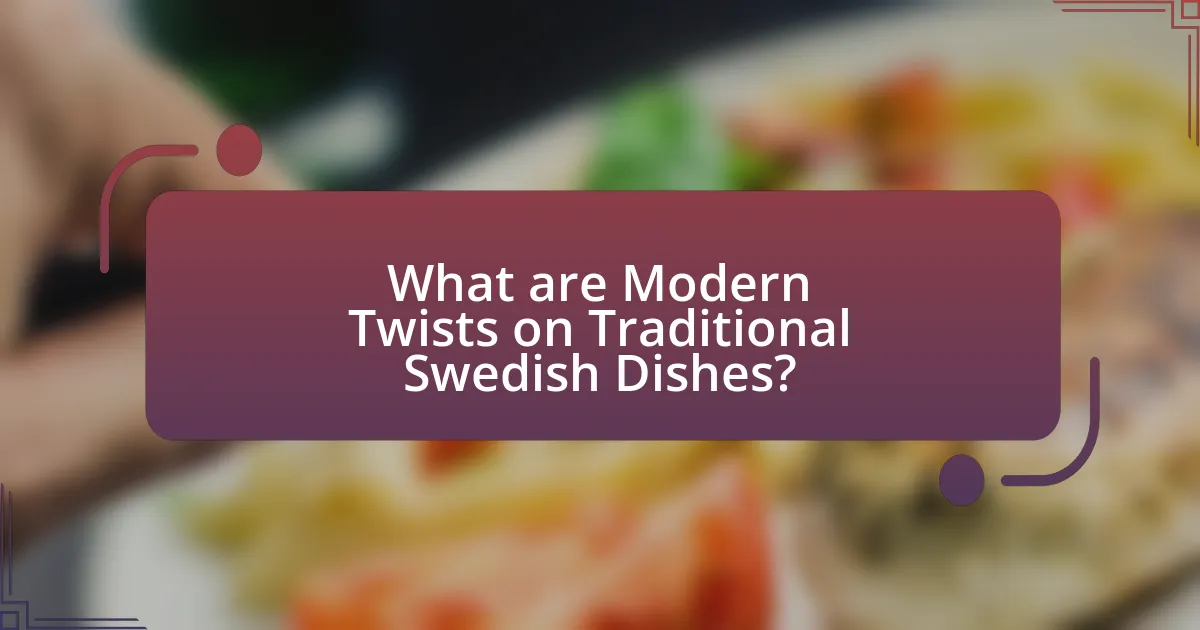
What are Modern Twists on Traditional Swedish Dishes?
Modern twists on traditional Swedish dishes include innovations such as plant-based meatballs, which replace the classic köttbullar with lentils or chickpeas, catering to vegetarian diets. Another example is the use of sourdough bread in smörgås, enhancing flavor and texture while maintaining the essence of the open-faced sandwich. Additionally, traditional gravlax is often reimagined with unique marinades, such as beetroot or citrus-infused variations, adding contemporary flair to the classic dish. These adaptations reflect a growing trend towards sustainability and health-conscious eating while honoring Swedish culinary heritage.
How are chefs reinterpreting Traditional Swedish Dishes today?
Chefs are reinterpreting traditional Swedish dishes today by incorporating global flavors and modern cooking techniques. For example, classic dishes like meatballs are being enhanced with spices from Middle Eastern cuisine, while traditional herring is often paired with innovative garnishes such as avocado or mango salsa. This fusion approach not only revitalizes the flavors but also appeals to contemporary palates, reflecting a broader trend in culinary arts where chefs blend heritage with innovation. The use of locally sourced ingredients remains a cornerstone, ensuring that while the dishes evolve, they still honor their Swedish roots.
What innovative techniques are being used in modern Swedish cooking?
Modern Swedish cooking employs innovative techniques such as fermentation, sous-vide cooking, and foraging. Fermentation is used to enhance flavors and preserve ingredients, reflecting traditional practices while introducing new tastes; for example, fermented herring is a staple that has evolved with contemporary methods. Sous-vide cooking allows for precise temperature control, resulting in perfectly cooked meats and vegetables, which is increasingly popular in Swedish fine dining. Additionally, foraging has gained traction, with chefs sourcing wild herbs, mushrooms, and berries to create unique dishes that celebrate local ingredients and seasonal availability. These techniques collectively represent a fusion of tradition and modern culinary practices in Sweden.
How do modern dietary trends influence Traditional Swedish recipes?
Modern dietary trends significantly influence Traditional Swedish recipes by incorporating healthier ingredients and adapting cooking methods to align with contemporary nutritional guidelines. For instance, the rise in popularity of plant-based diets has led to the substitution of meat with legumes and vegetables in classic dishes like köttbullar (meatballs), resulting in vegetarian or vegan versions that maintain the essence of the original recipe. Additionally, the emphasis on reducing sugar and processed foods has prompted chefs to modify traditional desserts, such as using natural sweeteners or whole grains in kanelbullar (cinnamon buns). These adaptations reflect a broader movement towards sustainability and health-conscious eating, as evidenced by the increasing availability of organic and locally sourced ingredients in Swedish cuisine.
What are some examples of Modern Twists on Traditional Dishes?
Modern twists on traditional dishes include Swedish meatballs served with quinoa instead of rice, gravlax tacos that combine traditional cured salmon with a Mexican tortilla, and a deconstructed herring salad presented in a jar for a contemporary aesthetic. These adaptations maintain the essence of the original dishes while incorporating new ingredients and presentation styles, reflecting current culinary trends.
How is the classic Smörgåsbord being transformed?
The classic Smörgåsbord is being transformed by incorporating contemporary culinary trends and diverse global flavors. Modern interpretations often feature a fusion of traditional Swedish dishes with international cuisines, such as Asian-inspired pickled vegetables or Mediterranean-style seafood. Additionally, there is a growing emphasis on sustainability and local sourcing, leading to the use of seasonal ingredients that reflect regional availability. This evolution is evident in restaurants and catering services that adapt the Smörgåsbord to cater to dietary preferences, including vegetarian and vegan options, thereby broadening its appeal.
What new flavors are being introduced to traditional dishes like Gravlax?
New flavors being introduced to traditional dishes like Gravlax include citrus, dill variations, and unique spice blends such as juniper and coriander. These modern twists enhance the classic recipe by adding freshness and complexity, appealing to contemporary palates. For instance, the incorporation of citrus zest not only brightens the dish but also complements the salmon’s richness, while juniper adds a fragrant, earthy note that elevates the overall flavor profile.
What role does presentation play in Modern Swedish Cuisine?
Presentation plays a crucial role in Modern Swedish Cuisine by enhancing the visual appeal and overall dining experience. In contemporary Swedish culinary practices, chefs prioritize aesthetics, using vibrant colors, artistic plating techniques, and thoughtful arrangement to elevate traditional dishes. This emphasis on presentation not only reflects the cultural value placed on food aesthetics in Sweden but also aligns with global culinary trends that prioritize visual impact. For instance, the use of locally sourced ingredients is often showcased through minimalist plating, allowing the natural beauty of the food to shine, which is a hallmark of modern Swedish gastronomy.
How does plating affect the dining experience of Traditional Dishes?
Plating significantly enhances the dining experience of traditional dishes by influencing visual appeal, perceived flavor, and cultural context. A well-executed presentation can elevate a dish, making it more inviting and stimulating appetite, as studies show that visual aesthetics can affect taste perception. For example, traditional Swedish dishes like gravlax or köttbullar presented with vibrant garnishes and thoughtful arrangement not only showcase the ingredients but also reflect cultural heritage, enhancing the overall dining experience. This connection between plating and cultural significance reinforces the appreciation of traditional cuisine, making the meal more memorable.
What are the visual trends in modern Swedish food presentation?
Modern Swedish food presentation emphasizes minimalism, vibrant colors, and natural elements. This trend reflects a focus on simplicity and the beauty of fresh ingredients, often showcasing dishes on clean, white plates to enhance visual appeal. Additionally, the use of garnishes like edible flowers and herbs adds a pop of color, while the arrangement of food in a way that highlights texture and form is increasingly popular. This approach aligns with the broader Nordic culinary movement, which values seasonal and locally sourced ingredients, as evidenced by the rise of restaurants like Noma in Copenhagen, which has influenced Swedish dining aesthetics.

How can you experience Traditional and Modern Swedish Dishes?
To experience Traditional and Modern Swedish Dishes, one can visit authentic Swedish restaurants that offer a diverse menu featuring classic dishes like meatballs and herring alongside contemporary interpretations. For instance, restaurants in Sweden often serve traditional dishes made with locally sourced ingredients, while modern establishments may incorporate international flavors and innovative cooking techniques. Additionally, participating in food festivals or culinary tours in Sweden provides opportunities to taste both traditional and modern dishes, showcasing the evolution of Swedish cuisine.
What are the best places to try Traditional Swedish Dishes?
The best places to try traditional Swedish dishes include Smorgastarteriet in Stockholm, known for its authentic flavors and seasonal ingredients, and Pelikan, also in Stockholm, which offers a classic Swedish dining experience with traditional dishes like herring and meatballs. Another notable location is Tradition, where visitors can enjoy a variety of Swedish specialties in a cozy atmosphere. These establishments are recognized for their commitment to preserving Swedish culinary heritage, making them ideal for experiencing traditional cuisine.
Which restaurants are known for their authentic Swedish cuisine?
Restaurants known for their authentic Swedish cuisine include Tradition, Pelikan, and Smorgastarteriet. Tradition, located in Stockholm, offers classic dishes like meatballs and herring, reflecting traditional recipes. Pelikan, also in Stockholm, has been serving Swedish food since 1903, emphasizing local ingredients and traditional flavors. Smorgastarteriet, situated in Malmö, combines traditional Swedish dishes with modern culinary techniques, showcasing a contemporary approach to classic recipes. These establishments are recognized for their commitment to preserving and presenting authentic Swedish culinary heritage.
How can you find modern interpretations of Swedish dishes in your area?
To find modern interpretations of Swedish dishes in your area, utilize online platforms such as Yelp, TripAdvisor, or Google Maps to search for local restaurants that specialize in Swedish cuisine. These platforms often feature user reviews and photos that highlight contemporary takes on traditional dishes. Additionally, social media platforms like Instagram can provide visual inspiration and recommendations by searching hashtags related to Swedish food, such as #SwedishCuisine or #ModernSwedish. Local food blogs or culinary websites may also showcase restaurants that offer innovative versions of classic Swedish dishes, providing a curated list of options in your vicinity.
What tips can help you recreate Traditional Swedish Dishes at home?
To recreate Traditional Swedish Dishes at home, focus on using authentic ingredients and traditional cooking methods. Authentic ingredients such as lingonberries, dill, and cardamom are essential for achieving the true flavors of Swedish cuisine. Traditional cooking methods, like slow-cooking and pickling, are also crucial; for example, making gravlax involves curing salmon with sugar, salt, and dill over several days. Additionally, studying classic recipes from Swedish cookbooks or reputable culinary websites can provide accurate guidance and techniques. This approach ensures that the dishes reflect the cultural heritage and flavors of Sweden.
What essential tools and ingredients do you need for Swedish cooking?
Essential tools and ingredients for Swedish cooking include a heavy-duty frying pan, a pot for boiling, a baking sheet, and a rolling pin, along with ingredients like potatoes, herring, lingonberries, dill, and rye flour. The frying pan is crucial for preparing traditional dishes such as meatballs, while the pot is necessary for boiling potatoes, a staple in Swedish cuisine. Baking sheets are used for making pastries like kanelbullar (cinnamon buns), and a rolling pin is essential for rolling out dough for various baked goods. Key ingredients like potatoes and herring reflect the agricultural and fishing heritage of Sweden, while lingonberries and dill are commonly used in sauces and accompaniments, showcasing the flavors typical of Swedish dishes.
How can you adapt Traditional recipes for modern dietary preferences?
To adapt traditional recipes for modern dietary preferences, one can substitute ingredients to meet specific dietary needs, such as using gluten-free flour instead of wheat flour for those with gluten intolerance. Additionally, reducing sugar and incorporating natural sweeteners like honey or maple syrup can cater to health-conscious individuals. For instance, traditional Swedish dishes like meatballs can be made with leaner meats or plant-based alternatives to accommodate vegetarian or lower-fat diets. These adaptations not only maintain the essence of the original recipes but also align with contemporary nutritional guidelines, making them more accessible to a wider audience.
